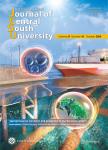Effect of Fe_2O_3/SiO_2 ratio on maghemite-silica particulate nanocomposites
Effect of Fe_2O_3/SiO_2 ratio on maghemite-silica particulate nanocomposites作者机构:Department of MechanicalUniversity of Malaya Department of Manufacturing and Materials EngineeringKulliyyah of EngineeringInternational Islamic University Malaysia
出 版 物:《Journal of Central South University》 (中南大学学报(英文版))
年 卷 期:2013年第20卷第11期
页 面:2954-2959页
核心收录:
学科分类:07[理学] 070205[理学-凝聚态物理] 08[工学] 080501[工学-材料物理与化学] 0805[工学-材料科学与工程(可授工学、理学学位)] 0702[理学-物理学]
基 金:Project(RP021-2012C)supported by University of Malaya under the UMRG Fund Malaysia
主 题:maghemite nanoparticles nanocomposites sol-gel silica
摘 要:Abstract: Maghemite-silica particulate nanocomposites were prepared by modified 2-step sol-gel process. Superparamagnetic maghemite nanoparticles were successfully produced using Massart's procedure. Nanocomposites consisting of synthesized maghemite nanoparticles and silica were produced by dispersing the as-synthesized maghemite nanoparticles into the silica particulate form. The system was then heated at 140 ℃for 3 d. A variety of mass ratios of Fe2O3/SiO2 was investigated. Moreover, no surfactant or other unnecessary precursor was involved. The nanocomposites were characterized using XRD, BET and AGM. The XRD diffraction patterns show the reflection corresponding to maghemite nanoparticles and a visible wide band at 20 from 20° to 35° which are the characteristics of the amorphous phase of the silica gel. The patterns also exhibit the presence of only maghemite and SiO2 amorphous phase, which indicates that there is no chemical reaction between the silica particulate gel and maghemite nanoparticles to form other compounds. The calculated crystallite size for encapsulated maghemite nanoparticles is smaller than the as-synthesized maghemite nanoparticles indicating the dissolution of the nanoparticles. Very high surface area is attained for the produced nanocomposites (360-390 m^2/g). This enhances the sensitivity and the reactivity of the nanocomposites. The shapes of the magnetization curves for nanocomposites are very similar to the as-synthesized maghemite nanoparticles. Superparamagnetic behaviour is exhibited by all samples, indicating that the size of the maghemite nanoparticles is always within the nanometre range. The increase in iron content gives rise to a small particle growth.



